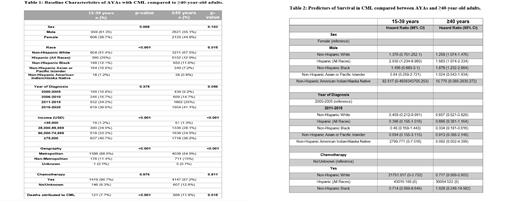Introduction:
Adolescents and Young Adults (AYA) are individuals between 15-39 years old. There are an estimated 1 million new cases of cancers in this age group yearly [1]. Although Chronic Myeloid Leukemia (CML) is typically a disease of middle-aged and elder patients, with a median age of 62 years [1], AYA accounts for about 22.1% of all CML cases [2]. There has been little focus directed towards this age group and most studies focus on the middle-aged and elderly. Despite the remarkable improvement in the survival of CML over the years, the largest study to date [3] suggested poor survival outcomes for patients in underserved populations and with low income. We aimed to determine whether sociodemographic differences exist in the AYA age group.
Method:
The Surveillance, Epidemiology, and End-Result (SEER) registry research plus database 17 (2000 -2020) was used to assess and compare the survival outcomes in the AYA group and older population diagnosed with CML. Both univariate and multivariate analyses were performed. Cox proportional hazards regression was used to determine prognostic factors for survival. A two-sided p-value ≤0.05 was considered significant.
Results:
A total of 6,319 patients with CML were identified, of which 75.2% (n= 4754) were adults ≥40 years, and 24.8% (n= 1565) were AYAs . Amongst the AYA, 51.4% (n=804) were Non-Hispanic White (NHW), 25 % (n=390) were Hispanics, 12.1% (n=189) were Non-Hispanic Black (NHB), 10.5% (n=164) were Non-Hispanic Asian or Pacific Islander (NHAPI) and 1.2% (n=18) were Non-Hispanic American Indian/Alaska Native (NHAIA) [Table 1]. The frequency of Hispanics in the AYA group was more compared to adults ≥40 years (25% vs 12.9%). NHWs had a lower frequency in the AYA group compared to adults ≥40 years (51.4% vs 67.5%) and NHBs had a similar distribution in both age groups (12.1% vs 11.6%). The proportion of mortality attributed to CML was lower in the AYA group compared to older adults ≥40 years (7.7% vs 11.9%). The results for individual Cox regression for each racial group show that AYA Hispanic males had a worse prognosis than females (HR= 2.930, 95% CI: 1.234-6.960), such observation was not seen in other AYA races [Table 2] but it was seen in Hispanic adult males ≥40 years (HR= 1.583, 95% CI: 1.074-2.334). Also, we identified that for patients aged ≥40 years, male sex was an independent poor prognostic factor for NHW (HR= 1.259, 95% CI: 1.074-1.476) and NWB (HR=1.879, 95% CI: 1.232-2.864) [Table 2].
Conclusion: Our study shows similar demographic characteristics between AYA and adults ≥40 years old. However, AYAs are less likely to die from CML compared to adults ≥40 years. Hispanic males appear to have a worse outcome than females, an observation seen in both age groups, and is independent of other analyzed prognostic factors. More research is needed to examine and identify other prognostic factors of CML in AYA with the aim of improving their survival outcomes.
References:
1. Nishiyama-Fujita Y, Nakazato T, Iriyama N, et al. Outcomes of adolescents and young adults with chronic-phase chronic myeloid leukemia treated with tyrosine kinase inhibitors. Ann Med. 2022 Dec;54(1):1244-1254.
2. Yanamandra U, Sahu KK, Karunakaran P, et al. Adolescent and Young Adult Chronic Myeloid Leukemia in Real-World Settings: Experience from a Tertiary Care Institute in Northern India. J Adolesc Young Adult Oncol. 2019 Feb;8(1):94-97.
3. Sobieski C., Vardell V, Tantravahi S. Racial and Ethnic Disparities in Survival Outcomes in Chronic Myeloid Leukemia. Blood 2022; 140 (Supplement 1): 1507-1508.
Disclosures
Becerra:Grunenthal Colombiana SA: Ended employment in the past 24 months.


This feature is available to Subscribers Only
Sign In or Create an Account Close Modal